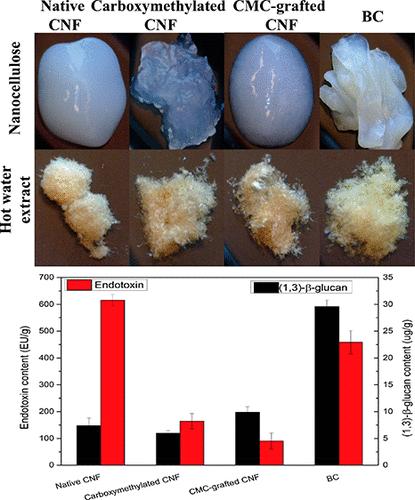当前位置:
X-MOL 学术
›
Biomacromolecules
›
论文详情
Our official English website, www.x-mol.net, welcomes your
feedback! (Note: you will need to create a separate account there.)
Potentially Immunogenic Contaminants in Wood-Based and Bacterial Nanocellulose: Assessment of Endotoxin and (1,3)-β-d-Glucan Levels
Biomacromolecules ( IF 5.5 ) Pub Date : 2017-12-07 00:00:00 , DOI: 10.1021/acs.biomac.7b01334 Jun Liu 1, 2 , Markus Bacher 3 , Thomas Rosenau 3, 4 , Stefan Willför 4 , Albert Mihranyan 1
Biomacromolecules ( IF 5.5 ) Pub Date : 2017-12-07 00:00:00 , DOI: 10.1021/acs.biomac.7b01334 Jun Liu 1, 2 , Markus Bacher 3 , Thomas Rosenau 3, 4 , Stefan Willför 4 , Albert Mihranyan 1
Affiliation

|
Knowledge gaps in the biosafety data of the nanocellulose (NC) for biomedical use through various routes of administration call for closer look at health and exposure evaluation. This work evaluated the potentially immunogenic contaminants levels, for example, endotoxin and (1,3)-β-d-glucan, in four representative NCs, that is, wood-based NCs and bacterial cellulose (BC). The hot-water extracts were analyzed with ELISA assays, HPSEC-MALLS, GC, and NMR analysis. Varying levels of endotoxin and (1,3)-β-d-glucan contaminats were found in these widely used NCs. Although the β-(1,3)-d-glucan was not detected from the NMR spectra due to the small extract samples amount (2–7 mg), the anomerics and highly diastereotopic 6-CH2 signals may suggest the presence of β-(1,4)-linkages with β-(1,6) branching in the polysaccharides of NCs’ hot-water extracts, which were otherwise not detectable in the enzymatic assay. In all, the article highlights the importance of monitoring various water-soluble potentially immunogenic contaminants in NC for biomedical use.
中文翻译:

木材和细菌纳米纤维素中潜在的免疫原性污染物:内毒素和(1,3)-β-d-葡聚糖水平的评估
通过各种给药途径,用于生物医学的纳米纤维素(NC)的生物安全性数据中的知识差距要求对健康和接触评估进行仔细研究。这项工作评估了四个代表性的NCs,即基于木材的NCs和细菌纤维素(BC)中潜在的免疫原性污染物水平,例如内毒素和(1,3)-β- d-葡聚糖。热水提取物用ELISA分析,HPSEC-MALLS,GC和NMR分析。在这些广泛使用的NC中,发现内毒素水平和(1,3)-β- d-葡聚糖污染程度各不相同。虽然β-(1,3) - d -葡聚糖从NMR谱由于小的提取物样品的量(2-7毫克),该anomerics和高度非对映异构6-CH中未检测到2信号可能暗示在NCs热水提取物的多糖中存在带有β-(1,6)分支的β-(1,4)-连接,否则在酶法测定中是无法检测到的。总之,本文强调了监视生物医学中NC中各种水溶性潜在免疫原性污染物的重要性。
更新日期:2017-12-07
中文翻译:

木材和细菌纳米纤维素中潜在的免疫原性污染物:内毒素和(1,3)-β-d-葡聚糖水平的评估
通过各种给药途径,用于生物医学的纳米纤维素(NC)的生物安全性数据中的知识差距要求对健康和接触评估进行仔细研究。这项工作评估了四个代表性的NCs,即基于木材的NCs和细菌纤维素(BC)中潜在的免疫原性污染物水平,例如内毒素和(1,3)-β- d-葡聚糖。热水提取物用ELISA分析,HPSEC-MALLS,GC和NMR分析。在这些广泛使用的NC中,发现内毒素水平和(1,3)-β- d-葡聚糖污染程度各不相同。虽然β-(1,3) - d -葡聚糖从NMR谱由于小的提取物样品的量(2-7毫克),该anomerics和高度非对映异构6-CH中未检测到2信号可能暗示在NCs热水提取物的多糖中存在带有β-(1,6)分支的β-(1,4)-连接,否则在酶法测定中是无法检测到的。总之,本文强调了监视生物医学中NC中各种水溶性潜在免疫原性污染物的重要性。











































 京公网安备 11010802027423号
京公网安备 11010802027423号